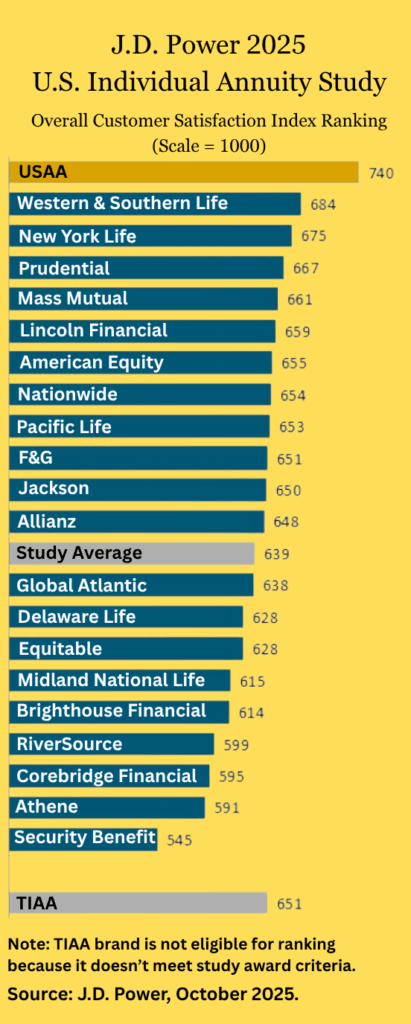
Last week the Financial Times reported: “Brighthouse Financial is seeking to sell itself, with some of the most prominent private capital managers expected to make bids for the US provider of life insurance and annuities.”
Though the report was not confirmed by Brighthouse management, the FT story moved the market.
Stock investors seized on the rumor of an acquisition, driving up the price of Brighthouse shares by 20% to $62, its highest level since 2018. Brighthouse was created in 2017 when MetLife spun off its retail annuities business as a separate company. The CEO since then has been MetLife veteran Eric Steigerwalt.
Brighthouse Financial, which has a current market value of ~$3.66 billion, consists of Brighthouse Life, Brighthouse Life of NY, New England Life, and a brokerage firm, Brighthouse Securities.
Veteran life insurance/annuity professionals were not so thrilled. Rather, many were dismayed by the possibility that Brighthouse might join the stream of U.S. annuity issuers that have been pulled into holding companies controlled by Apollo, KKR, Blackstone and other “alternative asset managers” that specialize in private credit origination.
The asset managers’ capital infusions gave new life to several life/annuity companies that were weakened by the low yields of investment grade bonds during the 2010s. The asset managers’ hoped to manage insurers’ existing general account assets and raise new revenue through annuity sales.
The annuity issuers were put in service of what RIJ has called the “Bermuda Triangle” strategy. It’s a business strategy whereby a global asset manager sources annuity liabilities in the U.S., uses offshore reinsurance to reduce capital requirements, and uses increasing portions of the reserves to finance high-risk, customized, illiquid, potentially high-return loans.
Brighthouse Life’s ~$112 billion in general account assets (i.e., policyholder and annuity contract owners’ money) should make it attractive to one of the half-dozen largest asset managers. Brighthouse also brought in $7.8 billion worth of annuity revenue in the first nine months of 2024, largely through the sale of registered index-linked annuities (RILAs), an SEC-regulated, broker-distributed type of variable annuity.
On the other hand, Brighthouse is burdened by blocks of legacy VAs with what, it turned out, were over-generous, under-priced guarantees. Contract owners were promised that they would never run out of income if they followed the contracts’ spending caps. MetLife and other big life/annuity companies sold more than a trillion worth of these products in the early years of this century before the stock market crash of 2008 and the Fed’s zero-interest-rate policy exposed the danger of trying to insure long-range equity returns.
Those VA/GLWBs, as they are often called, were once seen as a way for life insurers to capture a big chunk of Boomer savings. But they became an albatross instead. MetLife created Brighthouse in 2017 largely to get money-losing VA/GLWB blocks off its balance sheet, where they were depressing its share price.
“The VA book was a core part of what MetLife rolled into Brighthouse,” a former investment banker familiar with MetLife’s VA hedging program on the condition of anonymity. “At the time, Brighthouse crowed that the RILA business would be a natural offset for the VA risk. They would sell RILAs to grow their way out of legacy VAs.
“But Brighthouse couldn’t outrun its past. RILAs couldn’t make enough money to outrun the back-book. The [January 10] AM Best report indicated they’ve run out of the marginal benefit of the RILA book.”
On January 10, 2025, an AM Best release explained:
The operating performance has been dragged by the performance of the variable annuity (VA) and growth in registered index-linked annuity (RILA) lines of business, along with associated hedging programs. The losses in the VA and RILA lines of business were driven by strong equity markets and the structure of the hedging program.
At the start of third-quarter 2024, Brighthouse began to hedge new sales of its RILA products separately from legacy VA, after previously hedging them together. The run-off block the company inherited when it spun off from MetLife, Inc. has also contributed negatively to earnings. The company has experienced a statutory net loss of ($2.6) billion at year-end 2023, and a net loss of ($1.3) billion through third-quarter 2024.
Yet AM Best said in the same release that it was affirming Brighthouse’s overall A (excellent ) strength rating).
Troubling signals were coming out of Brighthouse a year ago. Yahoo! Finance reported in February 2024:
“Eric Steigerwalt, President and Chief Executive Officer of Brighthouse Financial Inc., sold 25,000 shares of the company on February 26, 2024, according to a recent SEC filing. The transaction was executed at an average price of $46.96 per share, resulting in a total value of $1,174,000… The recent sale by Eric Steigerwalt follows a pattern observed over the past year, where there have been no insider buys and five insider sells for Brighthouse Financial Inc.”
For old-school life/annuity professionals, it’s been painful to see so many once-venerable life insurers change hands since 2009. An annuity distribution professional and product developer who 10 years ago lamented this trend in a presentation to his peers told me in an email last week:
“What I missed, in retrospect was that this problem would get so much bigger in 10 years, that mainstream big life companies like MetLife would sell, that almost every legacy insurance company would do reinsurance with four or five offshore private equity-owned reinsurers, and that these transactions might leave the jar empty for the policyholder,” he said in an email to RIJ last week.
It’s difficult to predict what an asset manager might do with Brighthouse, aside from taking over the management of its general account. On the liability side, there’s a potential conflict. Brighthouse sells RILAs, which are securities that are distributed by advisers at brokerage firms. But the asset managers who now control much of the annuity industry prefer to sell fixed indexed annuities (FIAs), which are insurance products sold by insurance agents.
Those two businesses converge and overlap to some degree. For instance, the performance of RILAs and FIAs are both tied through options to the performance of equity or balanced indexes. Many advisers and agents are licensed to sell securities and insurance products.
Selling RILAs is different from selling FIAs. So far, the private equity/private credit firms have preferred to buy FIA issuers. They’ve stayed away from the big RILA issuers—former VA/GLWB issuers Equitable, Prudential, Nationwide, Lincoln—who are too big to gobble up and diversified enough to have survived the turbulence of the past 15 years. Whether they still have legacy VA/GLWB problems, and whether those problems are contained, I don’t know.
Hindsight is easy. But many life/annuity companies, after converting from mutual companies to stock companies 25 years ago, may have entered the big bad world of equities without a complete understanding of the risks. As “risk-buyers” (i.e., guarantee-sellers), they may also have come to the risk-selling” world of investments with a built-in disadvantage.
The 2008 stock market crash, in a sense, revealed their inexperience in that world. It’s possible that annuity businesses, by themselves, aren’t profitable enough to put up the kinds of quarterly numbers that investors crave.
As sources of new AUM, however, they appeal to asset managers. If an asset manager buys Brighthouse, I bet they’ll take it private.
© 2025 RIJ Publishing LLC.


